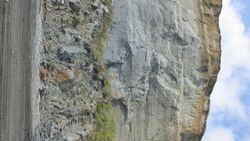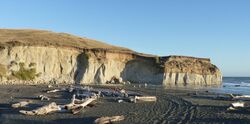Wanganui Basin
Topic: Earth
 From HandWiki - Reading time: 2 min
From HandWiki - Reading time: 2 min
The Wanganui Basin (also spelled Whanganui Basin) is an onshore-offshore basin on the North Island of New Zealand. The basin provides an important stratigraphic and palaeontological record for the late Neogene marine environment of New Zealand.[1][2][3]
Location and setting
The Wanganui Basin is located on the west coast of the North Island of New Zealand, within the Manawatū-Whanganui and Taranaki regions. The basin is roughly oval in shape, with the longer (approximately 180 kilometres (110 mi)) axis running west-south-west/east-north-east, and has a width of approximately 100 kilometres (62 mi). A little under half of the basin is onshore, extending inland around the lower reaches of the Whanganui and Rangitikei Rivers before terminating at the foot of the North Island Volcanic Plateau. The southern half of the basin extends into the South Taranaki Bight. The major population centre within the basin is along the coast, around the city of Whanganui.
Geology
Stratigraphy
The Wanganui Basin is "one of the most complete late Neogene marine stratigraphic records in the world,"[1] and is an important region for geological and palaeontological research.[2][3]
The basin provides the basis for the eponymous Wanganui epoch in the New Zealand geologic time scale, which covers the Pliocene, Pleistocene and Holocene over the last 5.33 million years.[1][4] The series was first described in depth and compared to glacial cycles by Charles Fleming,[3][5] which has had a lasting impact upon subsequent stratigraphic, palaeontological and palaeoecological research.[2] Each stage within the Wanganui epoch is named after regions of the Wanganui Basin series.[4]
Key sites
- Castlecliff
- Nukumaru
Palaeontology
Sediments within the basin are rich with shallow marine invertebrate fossils, including molluscs[5] and bryozoans.[6] The most common fossilized molluscan shells belong to the bivalve genera Dosinia and Chlamys and the gastropod genera Zethalia and Murex.[3] Shells of Aeneator, Buccinulum, Penion, Alcithoe, and Amalda marine snails are also frequent.[5]
See also
- Geology of Taranaki
- Stratigraphy of New Zealand
References
- ↑ 1.0 1.1 1.2 Carter, Robert M.; Naish, Tim R. (1998). "A review of Wanganui Basin, New Zealand: global reference section for shallow marine, Plio–Pleistocene (2.5–0 Ma) cyclostratigraphy". Sedimentary Geology 122 (1–4): 37–52. doi:10.1016/S0037-0738(98)00097-9. Bibcode: 1998SedG..122...37C.
- ↑ 2.0 2.1 2.2 Crampton, James S. M.; Cooper, Roger A. (2010). "The state of paleontology in New Zealand". Palaeontologia Electronica 13 (1). ISSN 1094-8074. https://palaeo-electronica.org/2010_2/commentary/zealand.htm.
- ↑ 3.0 3.1 3.2 3.3 "Dr Alan Beu". 18 May 2011. https://www.sciencelearn.org.nz/resources/1491-dr-alan-beu.
- ↑ 4.0 4.1 Beu, Alan G. (2001). "Local stages to be used for the Wanganui Series (Pliocene-Pleistocene), and their means of definition". New Zealand Journal of Geology and Geophysics 44 (1): 113–125. doi:10.1080/00288306.2001.9514928.
- ↑ 5.0 5.1 5.2 Beu, Alan G.; Maxwell, P.A. (1990). Cenozoic Mollusca of New Zealand. New Zealand Geological Survey Bulletin. 58. Lower Hutt, New Zealand: New Zealand Department of Scientific and Industrial Research. https://www.gns.cri.nz/gns/Home/Our-Science/Land-and-Marine-Geoscience/Paleontology/Online-Resources/Cenozoic-Mollusca-of-New-Zealand.
- ↑ Rust, S.; Gordon, D. (2011). "Plio-Pleistocene Bryozoan faunas of the Wanganui Basin, New Zealand: stratigraphic distribution and diversity". New Zealand Journal of Geology and Geophysics 54 (2): 151–165. doi:10.1080/00288306.2010.514928.
[ ⚑ ] 40°0′S 174°45′E / 40°S 174.75°E
 |
 KSF
KSF

